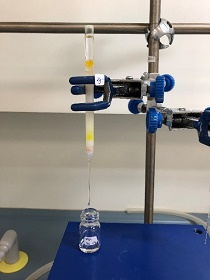Internship AMBI laboratory - Spain, Tenerife

In the spring of 2022 I left my hometown Groningen for a period of three months to live and study in the beautiful Canary Island of Tenerife. During this period I got the chance to carry out analyses for my ReMA archaeology thesis at the AMBI (Archaeological Micromorphology and Biomarkers) laboratory of the Universidad de la Laguna. At this laboratory, in which archaeologists and chemists collaborate, I was surrounded by an international group of researchers that could help me study the ancient soil samples that I had brought with me from the Netherlands. It was wonderful to be surrounded by people who understand and are experienced with the challenges of working with very old remains and know a lot about the chemistry of the soil and archaeological remains in the soil.

In my thesis I study the function(s) of Mesolithic (ca. 9200-5000 BC) pit hearths from various sites in the Netherlands, which are pits of ca. 1 m in diameter that were closed off to create oxygen-poor conditions and in which a fire was made. While numerous pit hearths have been discovered in the Netherlands, it remains unclear why Mesolithic hunter-gatherers dug those pits and what purpose(s) the fires lit inside those pits served. Were these pit hearths made as part of food processing, for instance to smoke meat? Were they made to produce tar, which may have had many uses such as glue in this period? Or are there other alternative uses of these pits? My goal is to learn more about the use(s) of these pit hearths by Mesolithic hunter-gatherers by looking at the chemical composition of the (burnt) soil and by hoping to find traces that provide indications of the original function(s) of these pits. At the AMBI lab it was possible to carry out biomarker or lipid analysis on the soil samples of pit hearths that I had brought along. Molecules related to the use of the pit hearths may still be present in the samples and may thus allow us to reconstruct the original function(s) of pit hearths; these molecules may be retrieved in biomarker or lipid analysis. The researchers at the AMBI lab taught me how to extract the lipids from the ancient soil samples, so that they could be analysed using GC/MS (gas chromatography-mass spectrometry). Upon this procedure individual molecules that may provide clues about the use of the pit hearths may be identified in the obtained spectrum. While the procedure of extraction itself was not very difficult to learn, I soon found out that my samples were rather time-consuming to extract due to the presence of large amounts of very fine charcoal in the samples. While charcoal is expected as a product of the burning (under anaerobic conditions, in this case), the amounts were astonishing. As a result, I did not only spend very long, but fun, hours in the lab, but I also got to rush through large numbers of filters and columns in the extraction process.
Outside of the lab I was able to enjoy the gorgeous volcanic island of Tenerife. My room was located in the capital of Tenerife, Santa Cruz, from which it was only a short drive by bus to both the ocean and the mountains. As a result, I spent many of my free weekends hiking in the nearby mountains. After the sometimes extremely steep climbs to cross the mountain ridges of nature resort Anaga, a refreshing swim in the ocean was very welcome and I have enjoyed this combination very much. A bit further away from the capital city the environment changed significantly towards dryer, rocky (volcanic) coastlines, which did not offer much shadow but were extremely beautiful to walk around on as well. One of the highlights of my trip to Tenerife was visiting the volcanic plateau around the biggest volcano of the island, El Teide. The many colours of dried out lava and ashes were astonishing. Due to the height of the volcano, the hikes were not the most easy ones, but most definitely some of the most impressive ones. All in all, I have very much enjoyed the experience of living and studying on Tenerife for a couple of months. Both the enthusiastic people in the laboratory, the possibilities offered to analyse my thesis samples in advanced ways, and the impressiveness of the nature parks of the island, in combination with the beautiful weather, made my internship in Tenerife an unforgettable journey. I am very grateful for the support of the GUF, without which this journey would not have been possible. To every student considering to carry out a project abroad, I can only say: go for it, it is an unforgettable and valuable experience!

